Kumar E.S. (ed.) Integrated Waste Management. V.I
Подождите немного. Документ загружается.

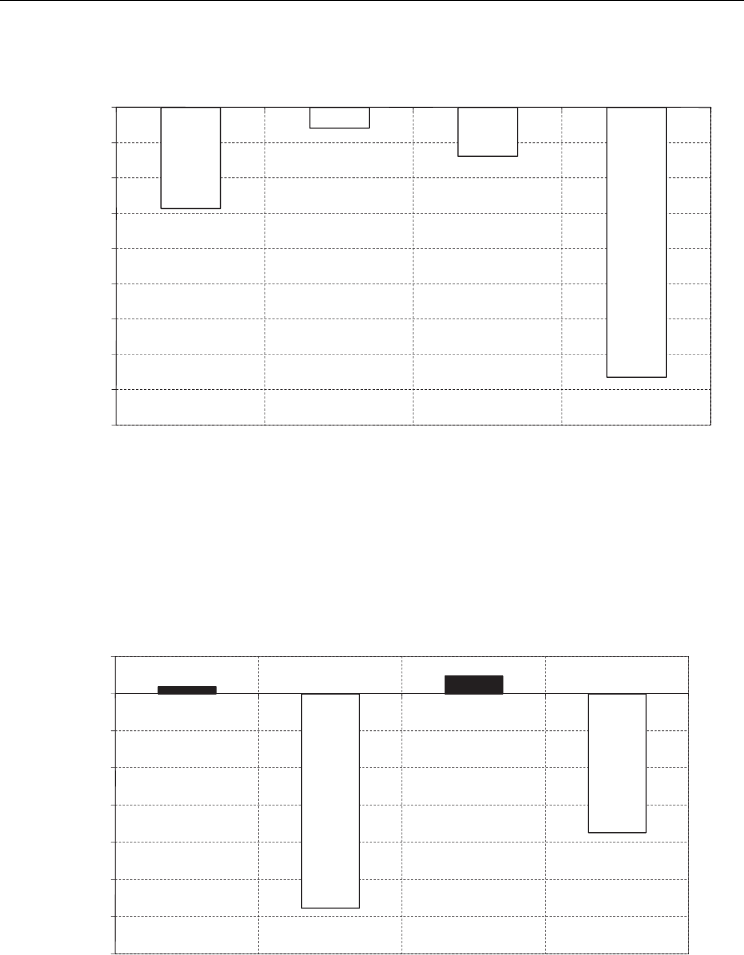
Comparison of the Suitability
of Two LCA Procedures in Selecting the Best MSW Management System
451
-0.45
-0.4
-0.35
-0.3
-0.25
-0.2
-0.15
-0.1
-0.05
0
Glass Aluminium Paper Compost
PDF m
2
year
Ecosystem Quality
Fig. 5. Difference between impact due to primary production and secondary production of
packaging materials and compost in terms of “Ecosystem Quality” (the Potentially
Disappeared Fraction, PDF, is the fraction of species that has a high probability of no
occurrence in a region due to unfavorable conditions)
-14
-12
-10
-8
-6
-4
-2
0
2
Glass Aluminium Paper Compost
MJ surplus
Resource Consumption
Fig. 6. Difference between impact due to primary production and secondary production of
packaging materials and compost in terms of “Resource Consumption” damage category
(MJ surplus expresses the surplus of Mega Joule needed in the extraction of resources when
the demand for these will be 5 times higher than it was in 1990)
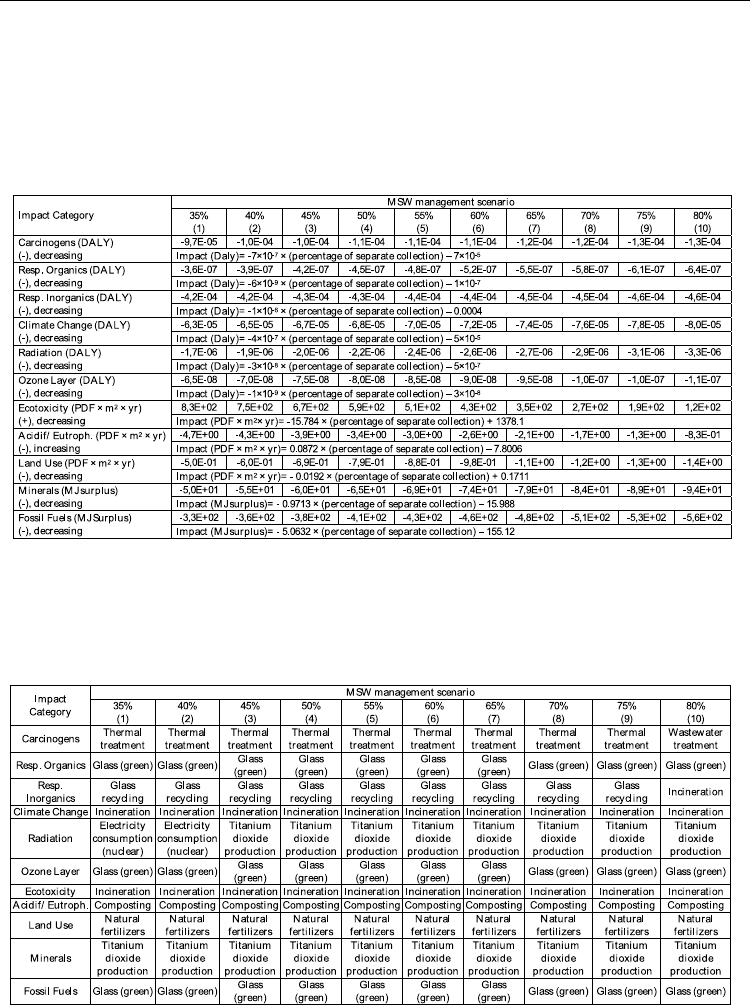
Integrated Waste Management – Volume I
452
Due to the simplified basic hypothesis of the adopted model, the modality of plastics
management was not considered when assessing the produced effects. Moreover, the
modality of paper management did not compare with the quantitative analysis of results,
with the analysis of single emissions highlighting that the balance between primary and
secondary production is essentially neutral. Finally, the implemented model was not
sufficiently adequate for the collecting and transporting phase, which would require the
implementation of another calculation model.
Table 16. Summary of the numerical results obtained with SimaPro for MSW management
scenarios 1-10 developed in terms of avoided or produced impact. (-) = avoided impact, (+)
= induced impact. Decreasing = the avoided or induced impact decreases with the
increasing of separate collection percentage; Increasing = the avoided or induced impact
increases with the increasing of separate collection percentage.
Table 17. Management phase with the greatest produced impact for each impact category
and for MSW management scenarios 1-10 developed in the study performed with SimaPro
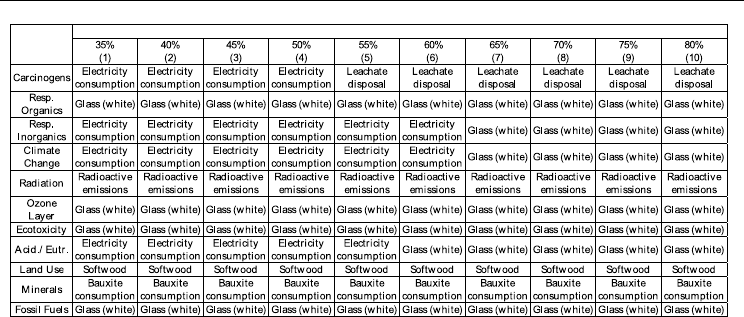
Comparison of the Suitability
of Two LCA Procedures in Selecting the Best MSW Management System
453
Table 18. Management phase with the greatest avoided impact for each impact category and
for MSW management scenarios 1-10 developed in the study performed with SimaPro
Table 17 indicates the management phase with the greatest produced impact for each impact
category as well as for MSW management scenarios 1-10 developed in the study performed
with SimaPro. “Glass (green)” resulted the heaviest phase 33 times out of 110 (10 scenarios x
11 impact categories), corresponding to 27.3%. While, “Incineration” and “Titanium dioxide
production” were the heaviest phase 20 times (18.2%) and 18 times (16.4%), respectively.
Table 18 indicates the management phase with the greatest avoided impact for each impact
category as well as for MSW management scenarios 1-10 developed in the study performed
with SimaPro. “Glass (white)” resulted the lightest phase 53 times out of 110, corresponding
to 48.2%. While, “Electricity consumption” was the heaviest phase 21 times (19.1%). Finally,
“Radioactive emissions”, “Softwood”, “Bauxite consumption” were the lightest phase 10
times each one (9.1%).
More detailed results in terms of impacts due to the several phases of the MSW
management system are presented in the next paragraphs in relation to the most significant
impact categories.
3.1.2 Climate change
The impact produced by dry residue incineration decreased linearly with the increasing of
the percentage of separate collection in terms of Climatic Change. A similar result was
obtained by Bruno et al. (2002), also indicating that the solution with incineration was more
environmentally sound than the solution with direct landfill disposal in terms of
Acidification and Global Warming. Eriksson et al. (2005) identified in the incineration the
management phase with the maximum production of CO
2
, while waste landfilling was
indicated as the worst option. The composting process of putrescibles was the management
phase which affected the most the production of induced impacts. The impact increases
linearly with the increasing of the percentage of separate collection. Arena et al. (2003)
pointed out that the worst solution was the direct landfill disposal in terms of Climate
Change, due to the emission of greenhouse gases, accordingly to the findings of Ozeler et al.
(2006). For the scenario with 70% of separate collection, the impact induced by the
composting process recycling overcame the impact induced by the dry residue incineration,
in terms of Climate Change damage category (Figure 7). A similar solution was found by
Bruno et al., (2002).
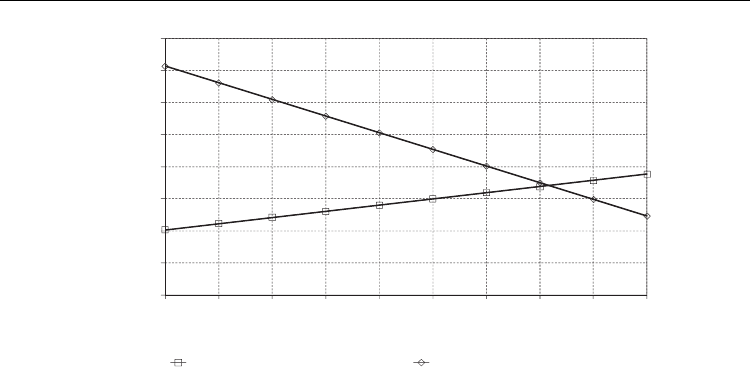
Integrated Waste Management – Volume I
454
0.0E+00
2.0E-05
4.0E-05
6.0E-05
8.0E-05
1.0E-04
1.2E-04
1.4E-04
1.6E-04
35 40 45 50 55 60 65 70 75 80
DALY
Percentage of separate collection [%]
Putrescible Composting Dry Residue Incineration
y = 8E-07 x + 1E-05
y = -2E-06 x + 0.0002
Fig. 7. Trend of the induced impacts by Putrescibles Composting and Dry Residue
Incineration in terms of “Climate Change”
3.1.3 Acidification/Eutrophication
The MSW management phase of putrescibles composting has an induced impact on the
category Acidification/Eutrophication as well as contributes to the negative results of the
damage macro-category Ecosystem Quality. A similar result was obtained by Eriksson et al.
(2004) considering the installation of an anaerobic digestion plant. While, different results
were obtained by Salhofer et al. (2007), who found lower impact in terms of the
Eutrophication of mechanical biological treatment rather than incineration. The avoided
impact is due to the energy recovery with the subsequent saving of fossil fuels. This amount
decreases with the increasing of the percentage of separate collection up to 60%, while for
greater percentages the maximum benefit is given by the glass production. The results are
shown in Figures 8 and 9.
3.1.4 Carcinogens
In scenarios with the incineration of dry residue (1-10), the avoided impact increases with
the percentage of separate collection due to the progressive reduction of the contribution of
the incineration process. The main contribution in positive terms was given by the energy
saving deriving from non-renewable sources.
In relation to scenario 20 (80% separate collection, mechanical sorting of dry residue), the
direct landfill disposal of dry residue (scenario 21) produced an increase of about one order
of magnitude in terms of the sub-category Carcinogens, thus determining a negative result
in terms of the damage category Human Health. Similarly, the landfilling of inert materials
and ashes of the combustion process (scenario 20) resulted in a negligible impact than that
due to the direct landfilling of dry residue in scenario 21. Similar results were obtained by
Bruno et al. (2002) who showed a significant impact of landfilling due to the release of heavy
metals downstream leachate treatment.
Figures 10 and 11 show the trend of induced impacts in terms of the damage category
“Carcinogens” by incineration and inert waste landfilling disposal, respectively.
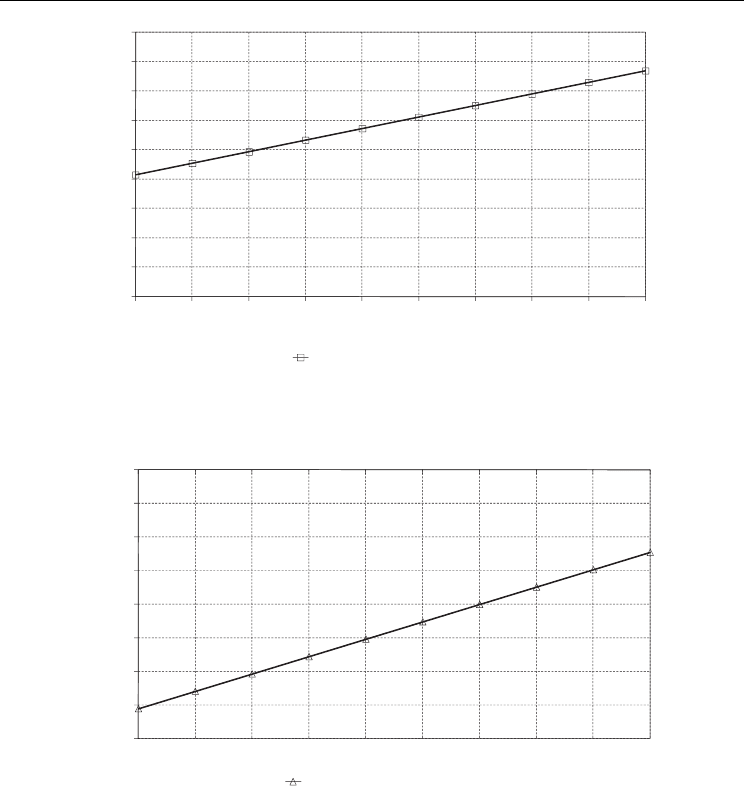
Comparison of the Suitability
of Two LCA Procedures in Selecting the Best MSW Management System
455
y = 0.0787 x + 1.3896
0
1
2
3
4
5
6
7
8
9
35 40 45 50 55 60 65 70 75 80
PDF m
2
year
Percentage of separate collection [%]
Putrescibles Composting
Fig. 8. Trend of induced impacts by the putrescibles composting in terms of damage
category “Acidification/Eutrophication”
y = 0.1034 x - 10.727
-8
-7
-6
-5
-4
-3
-2
-1
35 40 45 50 55 60 65 70 75 80
PDF m
2
year
Percentage of separate collection [%]
Electricity from Fossil Fuels
Fig. 9. Trend of induced impacts by the fossil fuels consumption in terms of damage
category “Acidification/Eutrophication”
3.2 Comparison of the results obtained with WISARD and SimaPro
One of the aims of this study was to compare the results obtained with the application of
two LCA procedures, WISARD and SimaPro, the first specific to the waste sector, while the
second of a general nature. In particular, applicability and reliability of the single procedure
to assess the life cycle of MSW management systems was evaluated.
It can therefore be deduced from the presentation of the results in the previous paragraphs
that the comparison between the two procedures can be performed only in qualitative rather
than quantitative terms because the mathematical models used for the analysis development
as well as representation of the obtained data are completely different.
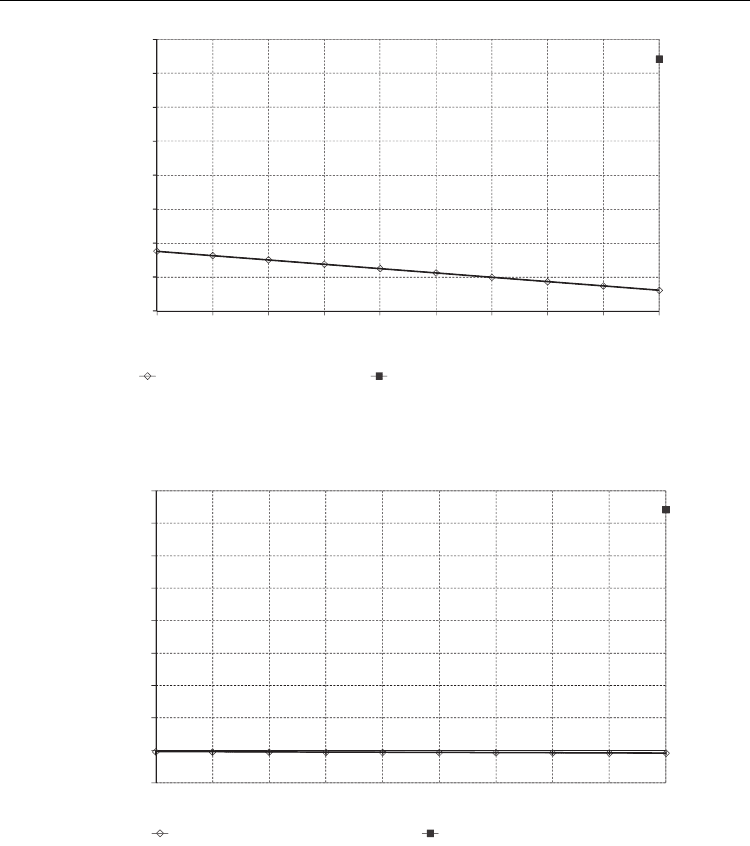
Integrated Waste Management – Volume I
456
0.0E+00
2.0E-05
4.0E-05
6.0E-05
8.0E-05
1.0E-04
1.2E-04
1.4E-04
1.6E-04
35 40 45 50 55 60 65 70 75 80
DALY
Percentage of separate collection [%]
Dry Residue Incineration Dry Residue Direct Landfill Disposal
y = -5 10
-7
x + 5 10
-5
Fig. 10. Trend of induced impacts by incineration in terms of damage category
“Carcinogens”
-2.0E-05
0.0E+00
2.0E-05
4.0E-05
6.0E-05
8.0E-05
1.0E-04
1.2E-04
1.4E-04
1.6E-04
35 40 45 50 55 60 65 70 75 80
DALY
Percentage of separate collection [%]
Inert Waste Landfill Disposal Discards Landfill Disposal
y = -2 10
-8
x - 3 10
-7
Fig. 11. Trend of induced impacts by inert waste landfill disposal in terms of damage
category “Carcinogens”
Since the procedure WISARD is applied only to MSW management systems, with this
procedure the results are presented only in terms of equivalent inhabitants. On the contrary,
the SimaPro procedure, being of a general nature, can be adopted for the application of Life
Cycle Assessment to all products, processes and activities. SimaPro, compared to WISARD,
allows for a simpler and direct interpretation of the results, even by non-technical users.
This is achieved with the presentation of the results in terms of the damage macro-
categories Human Health, Ecosystem Quality and Resource Consumption.

Comparison of the Suitability
of Two LCA Procedures in Selecting the Best MSW Management System
457
The comparison between the results obtained with the two LCA procedures show the
following similarities:
all the considered scenarios showed negative overall impact indicators, indicating that
the MSW management was environmentally sound compared with traditional methods
of production of matter and energy. In particular, this behaviour was more evident the
higher the percentage of waste collection;
environmental emissions due to secondary production processes were lower than the
corresponding emissions due to the primary production of packaging materials, with
the presented exception;
for a fixed percentage of separate collection, the solution with mechanical-biological
selection of dry residue showed a reduction of the environmental benefit depending on
the impact category take into account;
for the percentages of separate collection greater than 60%, the solution with
mechanical-biological selection of dry residue waste can be considered environmentally
equivalent to the solution with the incineration and landfilling of ashes.
Table 19 shows the comparison between the MSW management phases with major and
minor impacts for the WISARD and SimaPro procedures for the common Impact Category.
Obviously, the MSW management phase with the greatest avoided impact indicates an
environmental benefit, while the MSW management phase with the greatest produced
impact indicates any environmental damage.
The qualitative comparison shows the perfect coincidence between the overall performances
in terms of positive/negative values. While, the two LCA procedures showed a different
behaviour in terms of the identification of the MSW management phase which affected the
most the final result in terms of positive or negative impacts. The different behaviour is due
to the different assumptions and simplifications made during the construction of the system
and, particularly, in the implementation phase of the process units of the treatment and
disposal plants.
As shown in table 9, focusing only on the common impact categories, Plastics and Metals
Recycling and Glass Recycling was the MSW phase with the greatest avoided impacts for
WISARD and SimaPro, respectively.
As shown in table 19, the collection and transporting to the treatment plants has a significant
importance in the WISARD procedure, resulting as the phase with the greatest incidence on
the production of induced impacts. The same results were not achieved for the SimaPro
procedure because its general nature determined a major approximation in the construction
of the basic calculation model.
3.3 Comparison with SimaPro between scenarios with dry residue incineration or
sorting
The main aim of this paragraph is to compare the induced or avoided impacts due to
scenarios with dry residue incineration (1-10) and scenarios with dry residue sorting (11-20),
using SimaPro as an LCA tool. Firstly, it focused on the numerical results obtained with
SimaPro for MSW management scenarios 11-20 developed in terms of avoided or produced
impact. As shown in table 20, only for the damage category Acidification/Eutrophication do
the impact values increase with the separate collection percentage, thus indicating an
environmental negative effect due to the separate collection. On the contrary, for ten out of
the eleven impacts considered with SimaPro, the calculated value decreased with the
percentage of separate collection, thus confirming the environmental convenience to push
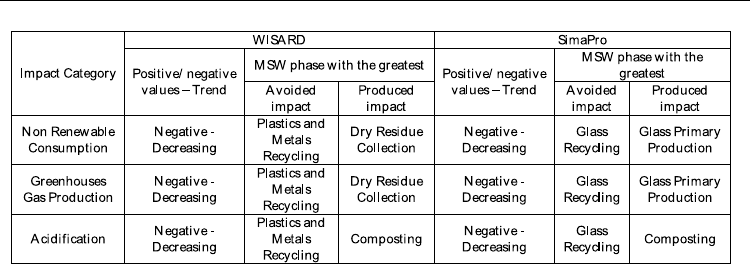
Integrated Waste Management – Volume I
458
Table 19. Comparison between the MSW management phases with major and minor
impacts for the WISARD and SimaPro procedures for the common Impact Category
up toward the maximization of separate collection. Moreover, for seven impact categories
(see Table 20 for more details), the impact values were positive therefore indicating that they
were avoided impacts (the integrated MSW management was environmentally sound in
terms of these damage categories). While, the damage category “Land Use” showed both
positive (for low levels of separate collection) and negative values (for high levels of
separate collection). Finally, the impact values for the three damage categories Carcinogens,
Ecotoxicity and Acidification/Eutrophication were only positive thus indicating that they
were induced impacts (the integrated MSW management was not environmentally sound in
terms of these damage categories). Table 20 gives the equation of the line giving the values
of avoided or induced impacts by MSW management scenarios for each damage category.
While, Tables 21 and 22 indicate the management phase with the greatest produced and
induced impact for each impact category as well as for MSW management scenarios 11-20
developed in the study performed with SimaPro, respectively.
Table 21 shows the management phases with the greatest produced impact for each impact
category as well as for MSW management scenarios 11-20 developed in the study performed
with SimaPro. “Glass (Green)” resulted the heaviest phase 33 times out of 110,
corresponding to 30%. While, “Landfill Disposal” was the heaviest phase 17 times,
corresponding to 15.5%. Finally, “Wastewater treatment”, “Glass Recycling”, “Electricity
consumption (nuclear)”, “Natural fertilizers” and “Titanium dioxide production” were
heaviest at the same manner: 10 times, corresponding to 9.1%.
Table 22 shows the management phases with the greatest avoided impact for each impact
category as well as for MSW management scenarios 11-20 developed in the study performed
with SimaPro. “Glass (White)” resulted the lightest phase 70 times out of 110 (10 scenarios x
11 impact categories), corresponding to 63.7%. While, “Leachate disposal”, “Radioactive
emissions”, “Softwood” and “Bauxite consumption” were lightest at the same manner: 10
times, corresponding to 9.1%.
From this point forward, the aim of the paragraph is to compare scenarios 1-10 with
scenarios 11-20 in order to qualitatively evaluate the environmental role of the incineration
in the considered model of MSW management system. First of all, the difference between
the values of Tables 20 (dry residue sorting scenarios) and 16 (dry residue incineration
scenarios) were calculated in order to evaluate which scenarios are more environmentally
sound in terms of the considered damage categories. The obtained results are condensed in
figures 14 and 15. Essentially, for 10 out of the 11 impact categories (all excluding

Comparison of the Suitability
of Two LCA Procedures in Selecting the Best MSW Management System
459
Table 20. Summary of the numerical results obtained with SimaPro for MSW management
scenarios 11-20 developed in terms of avoided or produced impact. (-) = avoided impact, (+)
= induced impact. Decreasing = the avoided or induced impact decreases with the
increasing of separate collection percentage; Increasing = the avoided or induced impact
increases with the increasing of separate collection percentage
Table 21. Management phase with the greatest produced impact for each impact category
and for MSW management scenarios 11-20 developed in the study performed with SimaPro
“Minerals”), the difference was positive therefore indicating that sorting scenarios were
heavier than the corresponding incineration scenarios. In particular, Figure 14 shows the
trend of the difference between the Sorting scenario impact and Incineration scenario impact
normalized in respect to the maximum impact value of each category for the following
damage categories: “Carcinogens”, “Resp. Organics”, “Resp. Inorganics”, “Climatic

Integrated Waste Management – Volume I
460
Change”, “Radiation”, “Ozone Layer”, “Ecotoxicity”, “Acidif/Eutroph.”, “Land Use” and
“Fossil Fuels”. As clearly shown in Figure 12, in terms of one of the ten listed impact
categories, an Incineration scenario is more environmentally sound than the corresponding
Sorting scenario with the difference linearly decreasing with the increasing of the percentage
of separate collection.
Table 22. Management phase with the greatest avoided impact for each impact category
and for MSW management scenarios 11-20 developed in the study performed with
SimaPro
Only for the damage category “Minerals” the difference between the Sorting scenario
impact and Incineration scenario impact was negative, thus indicating that sorting scenarios
were lighter than the corresponding incineration scenarios. As clearly shown in Figure 13, a
Sorting scenario is more environmentally sound than the corresponding Incineration
scenario with the difference linearly decreasing with the increasing of the percentage of
separate collection.
Since for ten out of the eleven impact categories, the difference between the impact of a
Sorting scenario and the impact of the corresponding (in terms of percentage of separate
collection) Incineration scenario was positive, it can be argued that in general Incineration
scenarios are more environmentally sound than the corresponding Sorting scenarios,
especially for low levels of separate collection. While, on the contrary, the difference tends to
diminish with the increasing of the percentage of separate collection.
4. Conclusion
The outputs from 12 out of 21 options modelled were initially analysed under eleven
environmental effect categories as suggested by the WISARD procedure, with the aim of
carrying out a synthetic study of the data available. The impact assessment categories
suggested are as follows: renewable energy use, non-renewable energy use, total energy use,
water, suspended solids and oxydable matters index, mineral and quarried matters,
greenhouse gases, acidification, eutrophication, hazardous waste, non-hazardous waste.
Attention was given to both measuring the overall impact due to the application of the
